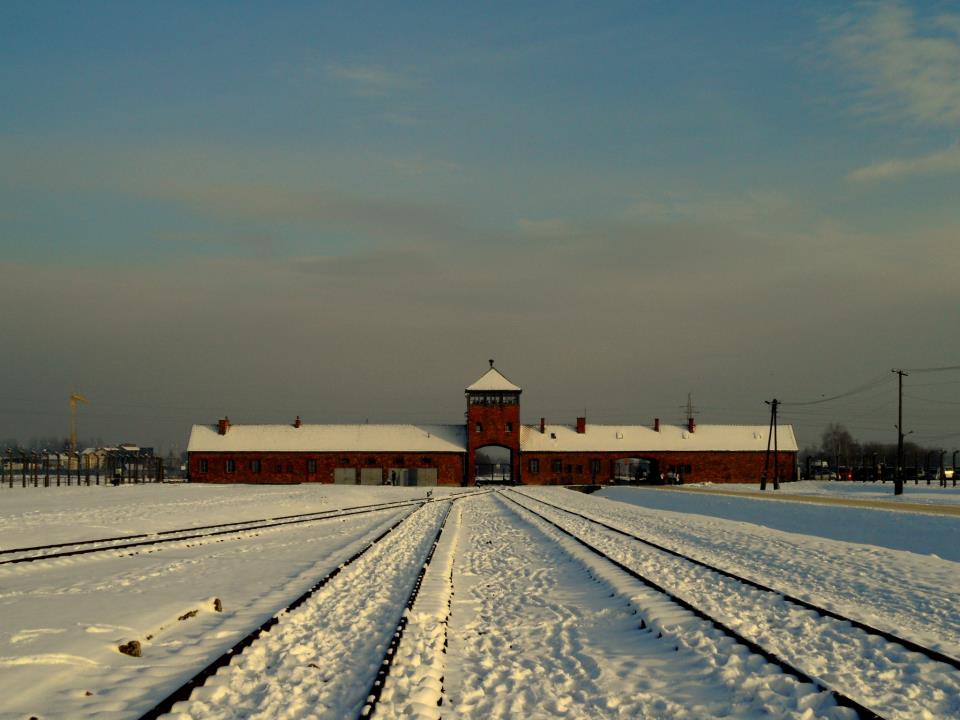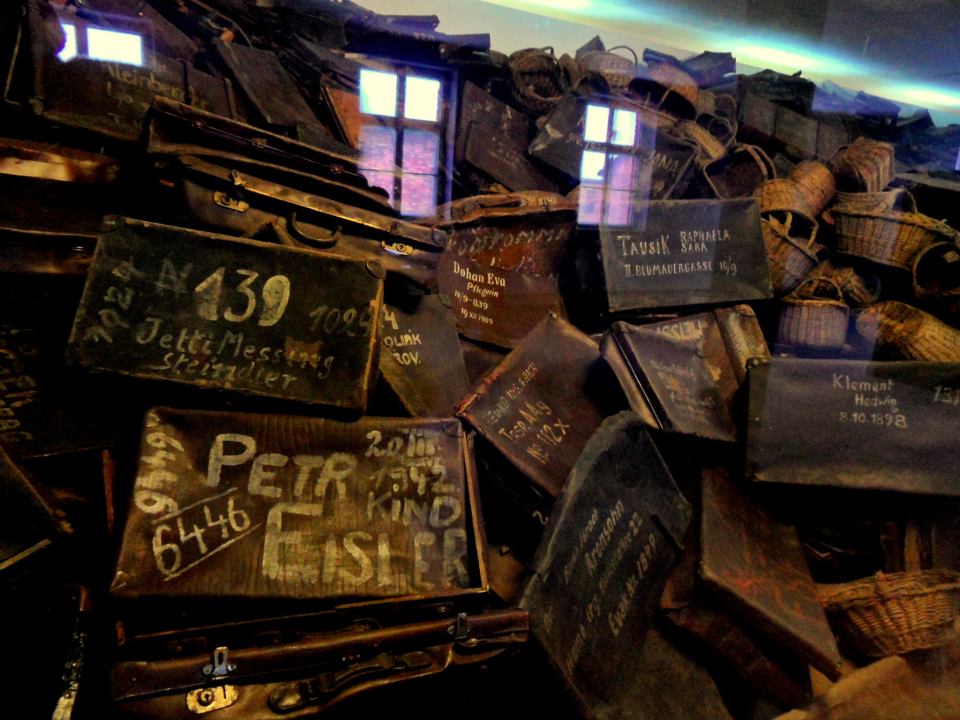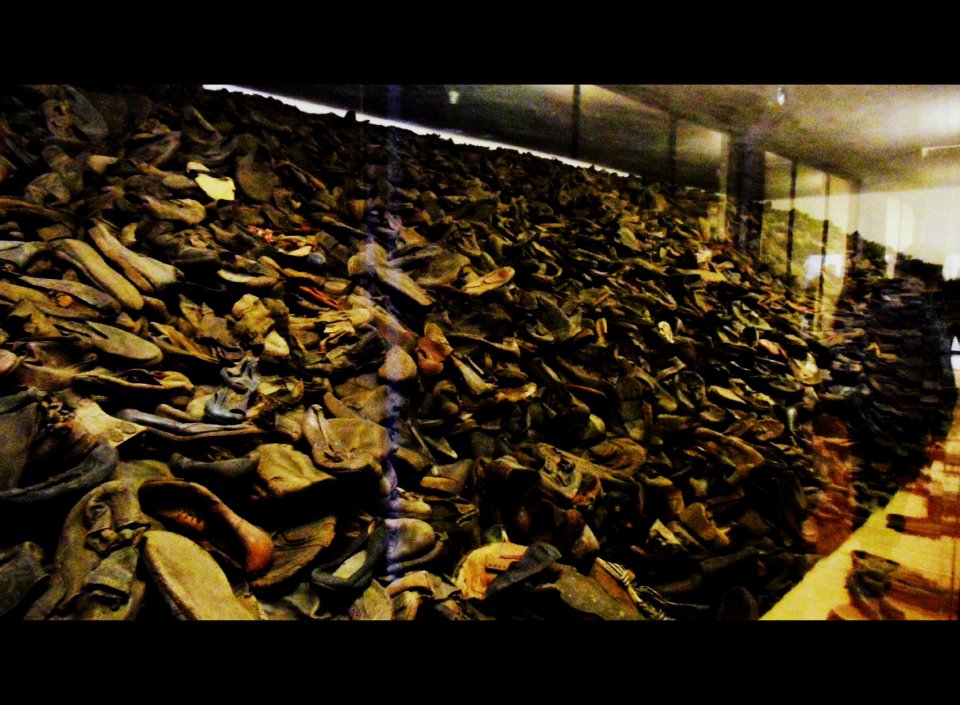On Friday, December 14th, 2012, I visited Auschwitz. 
I didn’t want to go. I was scared of what I’d see and what I’d imagine and how I’d never be able to forget any of it. But I went because I thought I had no right to be that frightened when I would be well-fed and warm and safe and free. I went because I was ashamed not to go.
We arrived in Auschwitz and joined a group of English speaking vistors and followed a knowledgeable guide around this bleak and silent place and listened to her describe indescribable suffering. When I looked at the relics – clothing and bags and combs and bowls and shaving brushes and antiquated artificial limbs – I couldn’t keep out the reality of the people who had owned them, no matter how hard I tried. Like hundreds of thousands of people before me I tried not to imagine the people who wore the clothes and the eyes that had focused behind the glasses now knotted into heaps. I tried not to see those same eyes reading the newspaper or peering through lenses to write poetry or shopping lists or fill out ledgers. Eyes that looked into other eyes and saw sunsets and beauty and horror.
When I looked at the vast, jumbled heap of human hair behind a glass panel it dissolved in front of me and instead of disembodied hair, I saw nimble fingers trimming and brushing and braiding the hair on small heads, not knowing it was destined to be hacked off their corpses to be sold to factories.
I tried not to see other things too.
Shoulders hunched against the wind, heads down to escape the cold and the cruelty. Big hands holding small hands and small hands holding smaller hands. Hands white-knuckled on the handles of heavy suitcases and bags. Shuffling towards the lie of a new life where you’d need the contents of a bag.
And I saw the feet as well. The fat baby feet being fastened into baby shoes. And the sore feet and tired feet and cold feet. Tramping, standing, walking, dancing, running – in boots and shoes and clogs. Inadequate peasant shoes and bespoke leather shoes…every colour, shape and size…and somehow the most real of all to me was the picture in my head of the young and beautiful feet that must have slid into the discarded red mules lying at the front of this monument to walking in suffering.
And all the time I was in Auschwitz, my head rang with a strange silence as we walked through the snow covered site and the guide recounted the stories of pain and victory and loss and cruelty and survival. All the time inside me ran constant, looping prayers for healing. It seemed idiotic to pray for healing for people who were long gone but I couldn’t stop the words unfurling and repeating inside my head.
Next day I realised that the healing prayers were for me – and my companions – trudging through this memorial of horror in the pristine snow. We needed the healing because witnessing any account of pain and horror is like being flayed by whips. Which is why we turn away from witnessing the pain of others.
Realising this made me understand that it was reasonable for me to be afraid and not want to go to Auschwitz. No human being walks willingly towards pain and this witnessing causes us real pain.
Because the truth is there is no significant difference between looking at our own pain and the pain of others. Whether this phenomenon is as a consequence of mirror neurons or learned empathy or something entirely different I don’t know, but I do know that looking at pain causes us pain and we all want to avoid that. It’s only natural.
But what I learned when I visited Auschwitz is that the cure is also the same. In both cases the only way to resolve the pain caused by suffering, to disarm the fear it creates, to stop it flourishing unchallenged, is to look it in the eye. To see it all. Look at every part of it and learn how it works and how to stop it happening.
Before I went to Auschwitz I’d been afraid to look because I was afraid my own pain would make me helpless and I’d be overwhelmed by the suffering.
Since I visited Auschwitz I learned some very important things –
- We need to look the suffering in the world in the eye and stare it down.
- It’s true that to really look at it hurts, but it passes – and after the pain and the overwhelming comes galvanizing.
And resolve.

Sobering piece Trish, never been and can’t begin to imagine the horror.
It was very instructive, though, Niamh. I’m glad I went there. Thanks.
If I could re-write only one page in history, it would be this…as well as ‘erase’ all who were responsible for authoring it.
I know, William, it was truly horrific. Unfortunately, there are still atrocities being committed in the world today, so I suppose we can try to erase those. Thanks for the thoughts.
Thank you for this! We too often turn away to spare ourselves and others the uncomfortable knowing of what humans are capable of. If we do not learn from history, it is repeated, with us just turning our heads away, yet being in part responsible …
I completely agree, we can’t afford to turn away and sadly I think you are right that when we do look the other way, we become complicit. Thanks for the comment.
Powerful. Very powerful. Thank you for your courage, and your willingness to share.
Thank you for your kindness, Amy
This is an amazingly powerful piece. Thank you for sharing what you’ve learned.
Thank you so much for your kind words, Lisa.
My parents took us to Auschwitz and many of the other memorials of this terrible time in history when we were children. My father didn’t think it was the thing to do, to take children but my mother was insistent. My brother didn’t understand, he was so young maybe 5. I cried, the whole time I cried as the guide told the stories and my mother made them more real, more horrifying on the drive away.
My mother was of German descent, first generation American. She had relatives who had fought on both sides of the war. She had relatives on both sides of the Berlin Wall. She wanted us to know in our bones what horror had been done.
You are right, we must look suffering in the eye. Then if we are human we must act.
Your mother sounds like a very interesting and insightful woman. I think she was correct to try to get you to understand – even if it was upsetting at the time. I’m sure it helped to develop your courage and resiliency as well as your compassion. Thanks.
Thank you for sharing your experience.
Thank you for reading and commenting.
You have written this so well and uncovered the truth of why we so often turn away. Thank you for making us look.
You are both welcome and very kind to be so nice about it. Looking is hard
Really excellent piece!
Thanks, Pat.x
Beautiful. I can’t imagine how hard it is to visit. I love your line we need to stare suffering down and not look away. We can make a difference.
Thank you so much for your kindness and – like you – I really do believe that is true. Thanks.